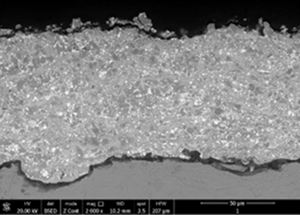
Authors: Alin Constantin Murariu, Ion Aurel Perianu
Abstract
In this paper, adhesion strength of WC–CrC–Ni coatings obtained by HVOF thermal spraying process of WOKA7504 powder has been studied in correlation with deposition thickness, chemical and structural properties. Besides the parameters strictly related to the process, deposition thickness was found to be the most significant factor affecting the adhesion strength. In the frame of experimental program 304L stainless steel and S235JR structural steel were used as substrate. Mechanical tests, SEM and EDX analysis, have been performed in order to assess structural and mechanical properties, phase composition of the deposited layers. Maximum average adhesion strength has been experimentally found of 23.4 N/mm2 for stainless steel and of 35.8 N/mm2 for structural steel, for a deposition thickness of 220 µm, achieved in two layers. Once the coatings’ thickness increases, the adhesion strength decreases constantly and over thickness of 400 to 650 µm, the existing coating imperfections and elongated carbides placed in the interlayer interface area could fail due to the thermal stresses during the HVOF thermal spraying process, since they are brittle stress concentrators and thus leading tocracking of coatings at small loads, since the coating layershave high hardness of 990 to 1151 HV 1.
Key words: protective coatings, tungsten carbide, HVOF, adhesive strength, failure mechanism
DOI: 10.24867/ATM-2019-1-006
